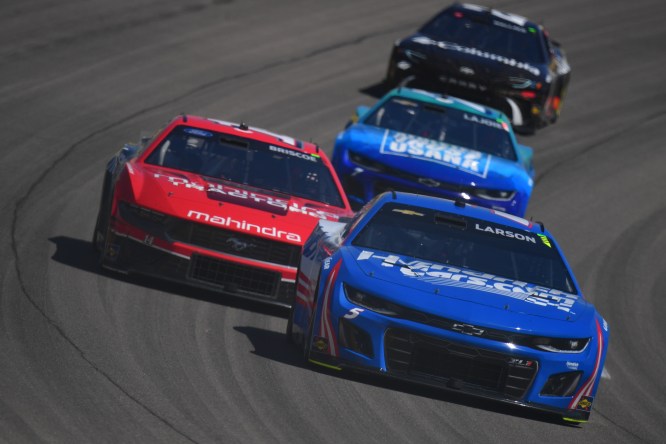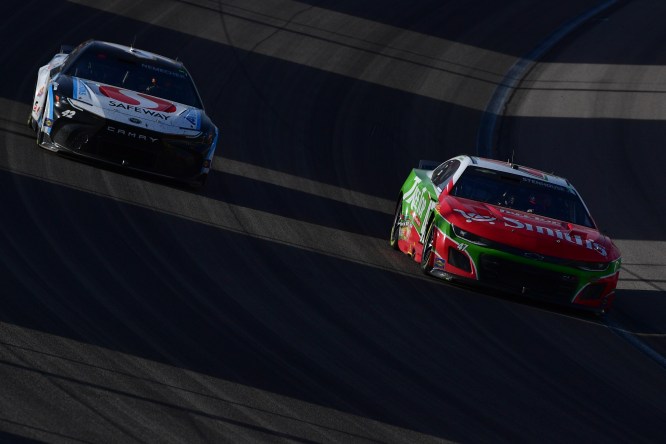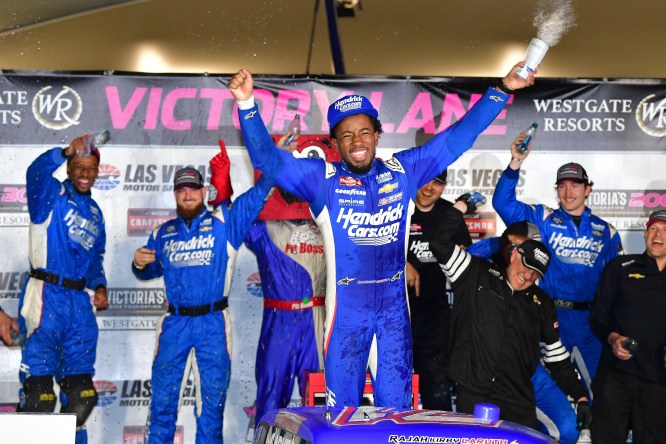
The season technically started over the weekend at Las Vegas Motor Speedway but it actually starts this weekend at Phoenix Raceway too.
Here’s why:
The 2024 NASCAR Cup Series campaign started with two drafting track races at Daytona and Atlanta. There are only six of those a year with the bulk of the schedule taking place on intermediate tracks like Vegas. The next largest bulk comes on shorter tracks like Phoenix, which also has a considerably different rules package in 2024, meaning everyone starts at square one this weekend.
So, what did we learn over the weekend at Las Vegas? It’s hard to say.
Kyle Larson won in a Chevrolet, continuing a strength at both this track and those like it for both Hendrick Motorsports and the manufacturer over the past two seasons, which makes sense because it’s the OEM with the least amount of change.
Chevrolet is still using the Camaro ZL1 body style that debuted alongside the NextGen platform in 2022 while both Ford Performance and Toyota are both working on a notebook for their new Dark Horse Mustang and Camry XLE models.

From that standpoint, having a now third year body was actually a source of strength for Hendrick, Chevrolet and the No. 5 team led by Larson and crew chief Cliff Daniels this weekend.
“We don’t have a new submission and we know the other OEMs do,” Daniels said during the post-race winner’s press conference. “Our sense of urgency is there. We know that we’ve got to keep evolving … the continuity of our stuff and keep understanding our stuff better.
“So, we still have to push. We still made setup changes from the fall to here because we didn’t quite have the long run pace that some other guys had in the fall. I would still argue we needed a little bit more today. We’ve got to keep evolving and we’ve got to keep pushing.”
Again, it’s so early, but there were points of optimism for both Ford and Toyota over what their new body styles could offer on the so-called downforce tracks this year.
Tyler Reddick nearly took 23XI Racing back to victory lane in the new Toyota
Both Noah Gragson and Chase Briscoe had top-10 or better speed in Stewart-Haas Fords
Ty Gibbs had a top-5 and Denny Hamlin had top-5 speed
Joey Logano won the pole and Ryan Blaney finished third
Again, it’s such a small sample size but Daniels says his primary takeaway after Vegas was just how much closer the entire field is at the start of the season, even more so than last year — the second year with a near identical spec racing platform.
“At the end of the year the Stewart-Haas cars weren’t always a top 5 threat, and they kind of were at times today,” Daniels said.
“The 23XI cars have been really strong at intermediates. They were today. The JGR cars were strong today. My assessment of today when I write my post-race notes on the plane tonight is going to be that the gap is tighter than what it was in the fall across the field.
“And I really believe that, and I think you see it just with the different players that were inside the top 14 at any point of the race and being pretty competitive. There was times I looked through the top 20 in the leaderboard, and if the leader ran a 31 flat, 20th ran like a 31.10. That’s pretty close.”
It stands to reason that the Ford and Toyotas are only going to get stronger once they get more data for their aero maps.
How aero maps work was best articulated by Denny Hamlin on Saturday.
“It’s information that takes aerodynamics of the car and puts it into a computer and that tells you how much grip you should have,” Hamlin said. “It’s what we use for simulation. … We make a lot of speculation until we race the car on tracks like this, until we can validate whether than data was true or false.”
Hamlin says the more data they have about how the car actually performs on the track beyond the expectations of what the simulator says, the better their set-up decisions will be.
That takes times so Ford and Toyota will continue to improve, while Chevrolet should have an advantage on these types of tracks because there is no change in the rules package and they have two years’ worth of information to lean on.
But that’s NOT true for this weekend at Phoenix because NASCAR landed on a new short track and road course rules package following an off-season tire and aerodynamics test.
Chevrolet has no tangible data on this year, nor does Toyota and Ford, who finalized this body style without any idea that the short track package would change. For these tracks this season, cars will be outfitted with a simplified rear diffuser and the rear spoiler has been raised to three inches.
The difference from last year can be viewed below.

The whole field will get a full 50 minute practice session, as opposed to the 15 minutes, and the cars will not be impounded afterwards. That means teams can make adjustments before the race based off what they learn in practice.
Daniels says he’s excited for that.
“The one thing that I am surprised about, and to tip you guys off a little bit for next week, is some of the aero map of that car and things that you have to look at different from the conventional aero map of the Next-Gen car,” he said.
“So it’s actually going to be exciting to get to go play that out and see how it goes. The drivers are really positive at the test that we were part of in December, January, whenever it was, just of what that aero package was going to be, and we’ve got to do stuff different to accommodate that.
“To be honest with you, it’s a bit of an unknown for everyone.”
So, again, from that standpoints, Phoenix also marks the real start of the season in the same way Las Vegas did. Combined, short tracks, road courses and intermediate tracks is NASCAR racing more than the six superspeedways.
So the race to decide who are really the teams to beat begins in March and not February.
Too early for standings but …

In the same way that it is too soon to really make any proclamations off just Las Vegas, three races is probably too small a sample size to get into any real points of consideration revolving around the playoff grid, and who may or may not be in trouble.
As a refresher, wins automatically transfer a driver into the playoffs with the remaining spots in the Field of 16 going to those without wins but with the most championship standings. There is, of course, an unlikely scenario that there are more than 16 regular season winners in 26 races but let’s dismiss that for now.
William Byron, Daniel Suarez and Kyle Larson have won their ways into the autumn dance.
List: The all-time consecutive seasons with at least one win
Here is what it looks like holistically:
Kyle Larson, Win, 7 playoff points
William Byron Win, 5 playoff points
Daniel Suarez Win, 5 playoff points
Ryan Blaney +44 1 playoff point
Martin Truex +38
Ross Chastain +32
Chase Elliott +29 1 playoff point
Kyle Busch +29
Ty Gibbs +21
Denny Hamlin +21
Austin Cindric +20 1 playoff point
Tyler Reddick +18
Alex Bowman +16
Bubba Wallace +10
Erik Jones +5
John Hunter Nemechek +2
—
Corey Lajoie -2
Ricky Stenhouse -4
Daniel Hemric -10
Chase Briscoe -15
Christopher Bell -16
Michael McDowell -16 1 playoff point
Chris Buescher -18
Joey Logano -20
Carson Hocevar -20
Harrison Burton -25
Austin Dillon -27
Brad Keselowski -28
Justin Haley -29
Josh Berry -31
Zane Smith -36
Todd Gilliland -36
Noah Gragson -43
Ryan Preece -54
Gragson and Preece are in trouble after their 35 point penalty last week, unless what Gragson showed on Sunday isn’t a one-off, and that Stewart Haas Racing has speed they simply haven’t shown over the first two years of the current generation car.
Gilliland had led the most laps after Daytona and Atlanta and had nothing to show for it but two DNFs and then finished last on Sunday.
Here’s the thing: Championship points are like bank transactions. Every DNF takes two to three repayments of good races to dig out of. It’s like compounding interest. You see that in Joey Logano, who failed to finish at Daytona and Atlanta, and is still 20 points out of a playoff spot with a ninth-place finish at Vegas.
It will be easier for drivers like Logano, Chris Buescher, Brad Keselowski and Christopher Bell because you expect them to race near the top-10 enough to score stage points too.
That’s what makes the start of the season for the likes of Preece, Gragson, Josh Berry, Austin Dillon and Carson Hocevar so disheartening because without the expectation of racking up stage points, it’s going to likely take a win or no more DNFs to even have a shot at the playoffs.
Conversely, that’s what makes a good start to important to Austin Cindric, Ty Gibbs, Erik Jones and John Hunter Nemechek. They weren’t heavy favorites to make the playoffs but they’ve immediately given themselves some cushion.
But again, it’s early yet and we still don’t know where all the teams and manufacturers shake out on every track type yet.
It is history

The day will come where Bubba Wallace and Rajah Caruth are no longer the only active Black drivers racing for wins across NASCAR’s three highest levels.
Their successes, alongside Kyle Larson and Daniel Suarez, are testaments to NASCAR’s Drive for Diversity program and a sporting culture that is way more inclusive than ever before. It’s a truism that isn’t only exemplified by the driver roster but also on pit crews all the way down pit road, in front offices across North Carolina and within the media center.
There are some who would dismiss the importance of Caruth joining Wallace and Wendell Scott as the only Black drivers to have won a NASCAR national touring race, suggesting that Caruth should only be looked as a driver like anyone else.
That’s fair in a just idealistic world but NASCAR isn’t entirely that world yet.
With every win that the Driver for Diversity graduates win at the highest levels, they inspire kids all across the continent, who now have someone to aspire towards. Where before, race winning drivers were not representative of the entire country, any given race could feature a victory lane that allows a kid to look in the mirror and say, ‘that could be me too.’
That’s important.
It’s important in the same way that Danica Patrick most recently aspired to win in Cup after winning in the IndyCar ranks or all the ways in which Toyota is trying to lay a path for a driver like Jade Avidisian or Taylor Reimer to win at the highest levels of motorsports.
How many women did Erin Evernham (nee Crocker) inspire with his success in 410 Sprint Cars and the World of Outlaws?
This matters.
Caruth himself will tell you that his Caribbean heritage is important, as is his impending graduation from a HBCU as the son of two professors, but it also isn’t the entirety of his identity.
“It’s authentic to my personality, how I grew up,” Caruth said of embracing the history narratives. “At the same time, it doesn’t necessarily define me. Hopefully, we can continue to grow in representation in NASCAR because we see it in pit crews, we’ve seen it in racing in engineering and PR, and hopefully with drivers more so it’s not the headline anymore … in the same way we don’t see that in other sports anymore.
“But that’s also because of the history of this sport, which is starting to change. I think, again, it’s authentic to me and I’m proud of it but it’s also not a whole personality trait.”
So here’s to a day where it’s not the headline anymore and NASCAR is certainly closer to that point than ever before in its history.
Matt Weaver is a Motorsports Insider for Sportsnaut. Follow him on Twitter.


